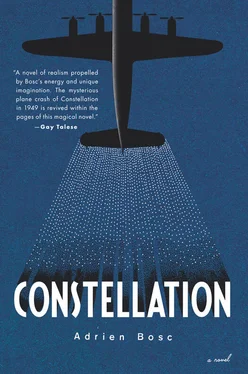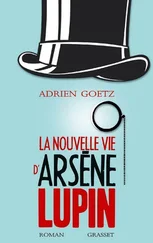
Amélie is flying on the Constellation toward a destiny she hardly could have hoped for, an extraordinary opportunity, truly incredible, which she had greeted with total disbelief a few weeks earlier. A spool operator in a textile mill in Mulhouse, Amélie is the eldest of ten children. “Amélie” is also the name of the potassium mine where her father works. North of Mulhouse lies a series of shafts named after Protestant heirs: Eugène, Alex, Joseph-Else, Fernand, Théodore, Max, Rodolphe. Her family lives in the workers’ village that the Mulhouse Industrial Society built near the mine works. Every morning, her brothers join her father in the potassium mines, while Amélie and her sisters work at the Dollfus-Mieg & Co. cotton mill — makers of the DMC yarns whose brand is posted on the storefronts of notions shops. The Ringler sisters are spoolers in the production of mouliné, a yarn whose cotton threads can be separated indefinitely. Spools, balls of yarn, skeins, carded and combed, put up in hanks, destined to be threaded through the eye of an embroidery needle. At Amélie’s cradle, no hidden fairy was present to foretell that the child would prick her finger on a spindle, yet her incredible story does include a godmother who watches over her fate. Amélie was in her twenty-seventh year when a letter of prophecy arrived. Her godmother had left Alsace for the United States in the 1930s. People knew she was rich, but no one imagined just how rich she was. She’d started as a worker in Detroit and become the director of a large factory for nylon stockings. A spinster and childless, she had focused all her energies on her career, and with her fortune now made, she was calling her goddaughter to her side. The whole family gathered on a September evening to read the letter from the almost forgotten aunt. Its message was not in doubt: Amélie was to be her sole heir. In the envelope was a money order for two hundred thousand francs to cover the cost of the trip.
Everything happened so quickly, and, at Orly on October 27, Amélie is still trying to take it all in. She wants the news confirmed firsthand; the prophecy still hangs in the air. It is her first trip, and she is sixteen thousand feet above an ocean she has never seen. The day before, in transit, she took advantage of some idle hours to wander through the Bon Marché department store. She bought a long green dress, a scarf, and a pair of nylon stockings from Schiaparelli. Amélie has long, dark hair, tied back under a black straw hat, her short bangs peeping out. Green, almond-shaped eyes. She wears a silver necklace with an Egyptian medallion, an ankh amulet, symbol of eternal life. Once inside Air France’s F-BAZN, she sits next to another young woman, Françoise Brandière. They are about the same age, could almost be sisters. While Amélie will catch a train to Detroit tomorrow at Grand Central Terminal, Françoise will board a second flight to Cuba.
Ten years later, Elsa Triolet would embark on her Age of Nylon trilogy — Roses à crédit, Luna-Park , and L’Âme — sketching a period still in the process of defining itself, a moment when people’s outlooks, tastes, and dreams were evolving. Amélie could have been one of the heroines of that narrative, a leading one. The cotton mill worker, a future queen of nylon production, the spooler from Old Europe who becomes an industrialist in the New World. The passage from the age of silk to the age of nylon, from a living to a synthetic fabric.
… 1027 millibars near the Azores, with a ridge of 1025 millibars extending toward Spain.
— Marie-Pierre Planchon, Météo marine (Marine forecast)
Several minutes have passed since ground control last radioed the Lockheed Constellation. Palpable anxiety, the plane should already be taxiing on runway number one at Santa Maria airfield. No sound, no light or explosion troubles the island’s clear sky. F-BAZN has vanished into thin air. The two controllers on duty in the tower send out another call in vain. The line stays silent. At 2:53 a.m. the alarm is raised. The searchers focus first on the expanse of sea around the Azores. The Constellation has foundered at sea, no other explanation is likely. “To founder at sea,” those maritime words, expressions, verbs …
To founder at sea, ply the seas, jump into the sea, take to the sea, go to sea, die at sea, toss a bottle into the sea, be drowned, swamped, lost at sea, carried off to sea, to harrow, scour, sail the Seven Seas, disappear at sea, crisscross the southern seas, drive toward, end up with one’s back against the sea, at the bottom of the sea, old salt, sea wolf, fortune of the sea, a high, a full, a low, a heavy sea, that retreats, lays bare, rises, roars, forms whitecaps, bites into, wears at, undermines, erodes the cliffs, washes the shore, sparkles, glitters, glows, subsides, goes glassy, retreats, foams, unfurls, crests and falls, an oily sea, a sea of ice, of sand, a secondary sea, a bordering sea, an inland sea, landlocked, cold, temperate, frozen, calm, angry, swollen, stormy, flat, tropical, Arthur Rimbaud’s star-studded and lactescent sea, the furious lapping of the tides, the sidereal archipelagos and the islands whose delirious skies are opened to the seafarer: Is it on these bottomless nights that the airplane falls asleep and enters exile?
The island’s rescue craft set forth on the ocean in search of the wreck and its survivors, as they hope, or its casualties, as they fear. Searchlights bolted to their bows, sweeping the reefs and the Atlantic as far as sight can reach. A black night, the wail of the siren, the coming and going of the lights, and the steadfast fear, mounting as the minutes pass inexorably. One-thirty a.m. on the archipelago. The dawn that will reveal the sea’s vast tracts is still some distance off. There’s no trace of an airplane around the patrol boats furrowing the reefs and distant waters, no fuselage, no wreckage, no cry of distress shatters the silence; only the restless sea, the sound of motors, of waves being pounded, of water lapping against hulls. A resonant silence. The silence you hear when, once at least, you make a night crossing, a deafening silence, massive, a sky that is empty and filled with stars, a paradox.
In his Almagest , a summation of mathematical and astronomical knowledge, Ptolemy offered the first analytical map of the celestial vault, identifying 1,022 stars and forty-eight constellations. In the Azores, after dusk, in an airplane named for a grouping of stars, forty-eight people go missing. At 2:00 a.m., 3:00 a.m., 4:00 a.m., 5:00 a.m., no sign awakens the Atlantic. Reflected in the infinite puddle are the Big and Little Dippers, Orion, and Scorpio.
“Hey, we’re here, us shepherds!”
— Jean Giono, Le serpent d’étoiles (The Serpent of Stars)
On Wednesday, October 26, 1949, five Basque shepherds stand on the platform of the Bordeaux-Saint-Jean train station. Their dream is to return home having made their fortunes. Four boys, one girl, all from farm families.
Thérèse Etchepare is a child of twenty with dark, almond-shaped eyes. She clutches her canvas bag to keep from crying. She will work as a domestic servant at a ranch in Tempe, Arizona. Three thousand animals, veal calves, cows, hogs. She’ll stay there for ten years. Then she’ll come home with her savings. She made the decision two months ago and, on Tuesday, dragged herself away from her family.
The oldest of the five shepherds, Guillaume Chaurront, is a handsome young man of twenty-eight. He feels no regret at leaving his village and has always dreamed of the wide-open plains, over there, in California.
Читать дальше













